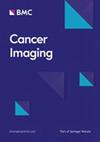放射组学通过反映肿瘤异质性和微环境预测透明细胞肾细胞癌患者的预后
IF 3.5
2区 医学
Q2 ONCOLOGY
引用次数: 0
摘要
我们的目的是开发并从外部验证一种基于CT的深度学习放射组学模型,用于预测透明细胞肾细胞癌(ccRCC)患者的总生存期(OS),并研究放射组学与肿瘤异质性和微环境的关联。研究收集了来自三家机构的512名ccRCC患者的临床病理数据和对比增强CT图像。从三维感兴趣区共提取了3566个深度学习放射组学特征。我们生成了深度学习放射组学评分(DLRS),并使用 TCIA 的外部队列验证了该评分。根据 DLRS 将患者分为高分组和低分组。相应的TCGA队列中的测序数据用于揭示不同放射组学评分组间肿瘤异质性和微环境的差异。此外,研究人员还利用单变量和多变量Cox回归来确定术后OS不良的独立风险因素。结合 DLRS 和临床病理特征,建立了一个综合模型。预测结果的解释采用了SHapley Additive exPlanation方法。在多变量Cox回归分析中,DLRS被确定为不良OS的独立风险因素。研究还调查了不同放射组学评分组的基因组状况。肿瘤细胞和肿瘤微环境的异质性在两组之间存在显著差异。在测试队列中,组合模型具有很好的预测性能,1年、3年和5年OS的AUC(95%CI)分别为0.879(0.868-0.931)、0.854(0.819-0.899)和0.831(0.813-0.868)。根据综合模型进行分层后,不同组间的生存时间存在明显差异。该模型具有很高的区分度和校准性,优于现有的预后模型(所有 p 值均小于 0.05)。综合模型结合了 DLRS 和重要的临床病理特征,可以对 ccRCC 患者进行预后预测。放射组学特征可以反映肿瘤的异质性和微环境。本文章由计算机程序翻译,如有差异,请以英文原文为准。
Radiomics predicts the prognosis of patients with clear cell renal cell carcinoma by reflecting the tumor heterogeneity and microenvironment
We aimed to develop and externally validate a CT-based deep learning radiomics model for predicting overall survival (OS) in clear cell renal cell carcinoma (ccRCC) patients, and investigate the association of radiomics with tumor heterogeneity and microenvironment. The clinicopathological data and contrast-enhanced CT images of 512 ccRCC patients from three institutions were collected. A total of 3566 deep learning radiomics features were extracted from 3D regions of interest. We generated the deep learning radiomics score (DLRS), and validated this score using an external cohort from TCIA. Patients were divided into high and low-score groups by the DLRS. Sequencing data from the corresponding TCGA cohort were used to reveal the differences of tumor heterogeneity and microenvironment between different radiomics score groups. What’s more, univariate and multivariate Cox regression were used to identify independent risk factors of poor OS after operation. A combined model was developed by incorporating the DLRS and clinicopathological features. The SHapley Additive exPlanation method was used for interpretation of predictive results. At multivariate Cox regression analysis, the DLRS was identified as an independent risk factor of poor OS. The genomic landscape of different radiomics score groups was investigated. The heterogeneity of tumor cell and tumor microenvironment significantly varied between both groups. In the test cohort, the combined model had a great predictive performance, with AUCs (95%CI) for 1, 3 and 5-year OS of 0.879(0.868–0.931), 0.854(0.819–0.899) and 0.831(0.813–0.868), respectively. There was a significant difference in survival time between different groups stratified by the combined model. This model showed great discrimination and calibration, outperforming the existing prognostic models (all p values < 0.05). The combined model allowed for the prognostic prediction of ccRCC patients by incorporating the DLRS and significant clinicopathologic features. The radiomics features could reflect the tumor heterogeneity and microenvironment.
求助全文
通过发布文献求助,成功后即可免费获取论文全文。
去求助
来源期刊

Cancer Imaging
ONCOLOGY-RADIOLOGY, NUCLEAR MEDICINE & MEDICAL IMAGING
CiteScore
7.00
自引率
0.00%
发文量
66
审稿时长
>12 weeks
期刊介绍:
Cancer Imaging is an open access, peer-reviewed journal publishing original articles, reviews and editorials written by expert international radiologists working in oncology.
The journal encompasses CT, MR, PET, ultrasound, radionuclide and multimodal imaging in all kinds of malignant tumours, plus new developments, techniques and innovations. Topics of interest include:
Breast Imaging
Chest
Complications of treatment
Ear, Nose & Throat
Gastrointestinal
Hepatobiliary & Pancreatic
Imaging biomarkers
Interventional
Lymphoma
Measurement of tumour response
Molecular functional imaging
Musculoskeletal
Neuro oncology
Nuclear Medicine
Paediatric.
 求助内容:
求助内容: 应助结果提醒方式:
应助结果提醒方式:


